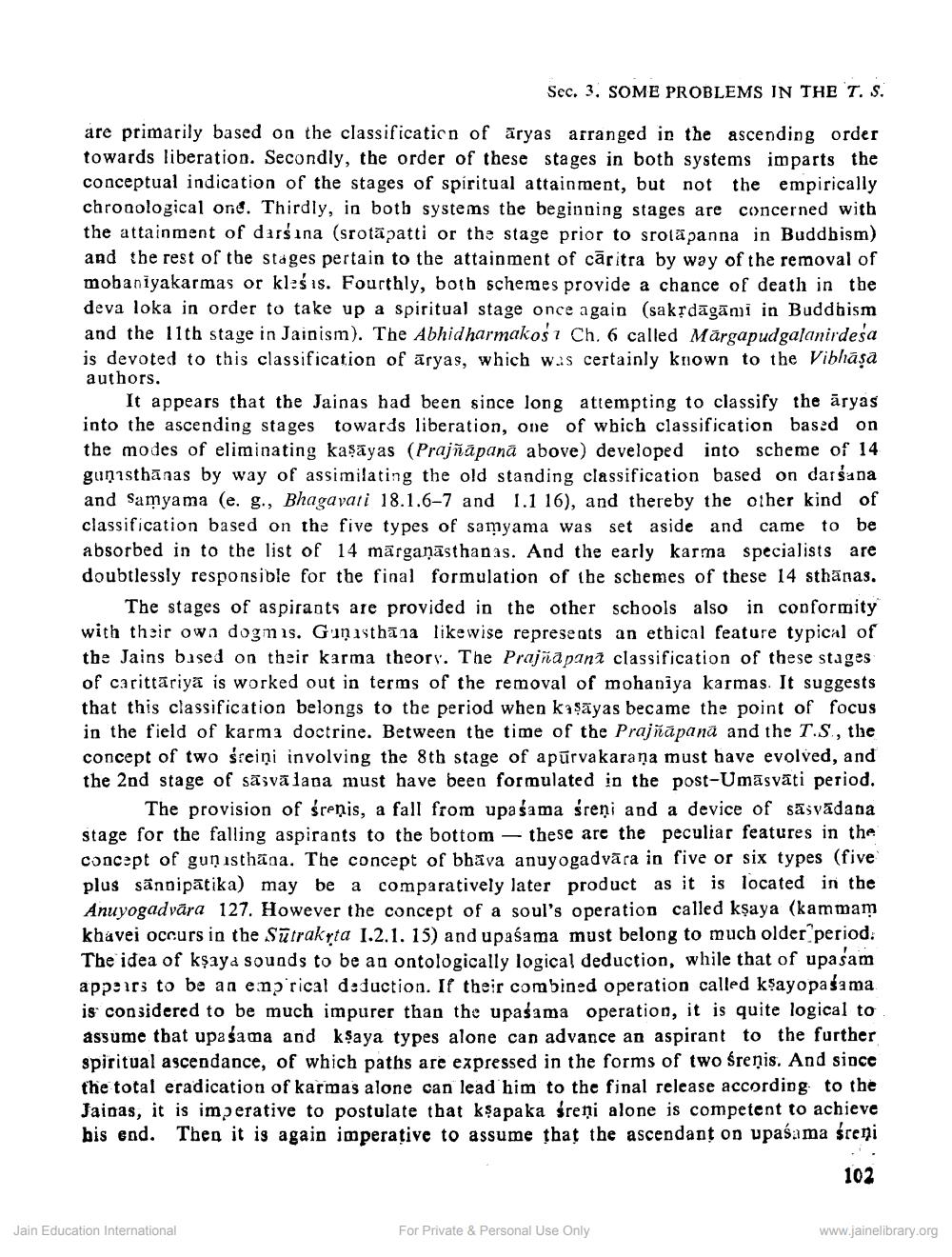________________
Sec. 3. SOME PROBLEMS IN THE T. S.
are primarily based on the classification of aryas arranged in the ascending order towards liberation. Secondly, the order of these stages in both systems imparts the conceptual indication of the stages of spiritual attainment, but not the empirically chronological one. Thirdly, in both systems the beginning stages are concerned with the attainment of darsina (srotapatti or the stage prior to sroläpanna in Buddhism) and the rest of the stages pertain to the attainment of caritra by way of the removal of mobaniyakarmas or kl:sis. Fourthly, both schemes provide a chance of death in the deva loka in order to take up a spiritual stage once again (sakrdagami in Buddhism and the 11th stage in Jainism). The Abhidharmakoś Ch. 6 called Märgapudgalanirdesa is devoted to this classification of aryas, which was certainly known to the Vibhasa authors.
It appears that the Jainas had been since long attempting to classify the aryas into the ascending stages towards liberation, one of which classification based on the modes of eliminating kasayas (Prajñāpanā above) developed into scheme of 14 gunisthanas by way of assimilating the old standing classification based on darsana and Samyama (e. g., Bhagavati 18.1.6-7 and 1.1 16), and thereby the other kind of classification based on the five types of samyama was set aside and came to be absorbed in to the list of 14 märganasthanas. And the early karma specialists are doubtlessly responsible for the final formulation of the schemes of these 14 sthanas.
The stages of aspirants are provided in the other schools also in conformity with their own dogmis. Ganasthana likewise represents an ethical feature typical of the Jains based on their karma theory. The Prajñapant classification of these stages of carittariya is worked out in terms of the removal of mohaniya karmas. It suggests. that this classification belongs to the period when kasayas became the point of focus in the field of karma doctrine. Between the time of the Prajñāpana and the T.S., the concept of two śreini involving the 8th stage of apurvakarana must have evolved, and the 2nd stage of sasvaiana must have been formulated in the post-Umasväti period. The provision of śrenis, a fall from upašama śreņi and a device of sasvadana stage for the falling aspirants to the bottom-these are the peculiar features in the concept of gun isthana. The concept of bhava anuyogadvara in five or six types (five) plus sannipatika) may be a comparatively later product as it is located in the Anuyogadvara 127. However the concept of a soul's operation called kṣaya (kammam khavei occurs in the Sutrakyta 1.2.1. 15) and upasama must belong to much older period. The idea of kşaya sounds to be an ontologically logical deduction, while that of upasam appears to be an empirical deduction. If their combined operation called kṣayopasama. is considered to be much impurer than the upasama operation, it is quite logical to assume that upasama and kṣaya types alone can advance an aspirant to the further spiritual ascendance, of which paths are expressed in the forms of two śreņis. And since the total eradication of karmas alone can lead him to the final release according to the Jainas, it is imperative to postulate that kṣapaka śreņi alone is competent to achieve his end. Then it is again imperative to assume that the ascendant on upasama śreņi
102
Jain Education International
For Private & Personal Use Only
www.jainelibrary.org




